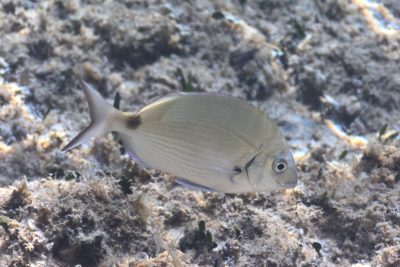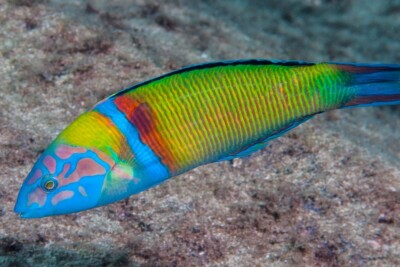annular seabream
| Scientific name | Diplodus annularis |
|---|---|
| Descriptor | Linnaeus |
| Year of description | 1758 |
| IUCN category (World) | LC |
| Family | Sparidae |
| Genus | Diplodus |


Introduction
The annular seabream, Diplodus annularis, is found on the east coast of the Atlantic Ocean, from Mauritania to Brittany. It is also present in the Black Sea and the Mediterranean.
Its abundance varies depending on the regions and fishing pressure. Easily observed from the surface, it is a good indicator of the quality of coastal marine ecosystems.
Who is it?
Morphology
-
Type
-
Average size13 cm
-
Maximum size28 cm
-
ShapeOvoid
-
Patternponctuations
-
Type
-
Average size13 cm
-
Maximum size28 cm
-
ShapeOvoid
-
Patternponctuations
How to recognize This fish ?
The annular seabream has a flat, oval body. It ranges in size from 12 to 27.5 centimeters.
The coloration is light gray with silvery and greenish reflections, the top of the head and the base of the caudal fin are slightly yellowish. The pelvic fins are yellow as well as the first rays of the anal fin. A black spot is present on the caudal peduncle.
Juveniles are generally yellow. This color gives way to silvery gray as they grow (from tail to head).
Sexual dimorphism
Male and female are not easily distinguishable. Although the sexes are separate, cases of protandrous hermaphroditism have been reported.
Behaviour & Life cycle
-
dietcarnivorous
-
Sociabilityliving in a group or alone
-
territorialNo
-
Way of livingdiurnal
The annular seabream generally lives in small groups. It is sometimes observed alone. It is a territorial fish and it is not uncommon to observe fights between two specimens.
In nature, this small predator feeds on mussels and other invertebrates in rocky areas. The powerful dentition of this species allows it to break shells and sea urchins.
Reproduction
Sexual maturity occurs at around 2 years, with a size of about 10 centimeters.
Spawning depends on the water temperature. It occurs from April to June for Atlantic populations and until July-September for Black Sea populations.
The larvae are planktonic and juveniles are observable up to 15 meters deep.
Harmless species
Origin and distribution
What is its habitat?
Natural environment characteristics
-
Depth0 - 90 m
-
FlowStrong
Biotope presentation
The annular seabream is most commonly found at depths less than 90 meters. It is common at shallow depths (10-15 meters) and can be observed near the surface.
This species lives near rocky areas and above seagrass beds. Annular seabream can also be observed in lagoons and ports.
Species of the same biotope
To go further
Sources & Contributions
Participation & Validation
The Fishipedia team and specialist contributors are committed to providing high-quality content. However, although the information comes from scientific sources or testimonials from specialists, the cards may contain inaccuracies.

Adrien Falzon

Benoit Chartrer

Julie Magnus
Translation
Translation done with the valuable contribution of our translators, who make this information available to a wider audience. We sincerely thank them for their commitment.
Bibliographic references
Reproductive biology of four Diplodusspecies Diplodus vulgaris, D. annularis,D. sargus sargus and D. puntazzo (Sparidae)in the Gulf of Tunis (central Mediterranean) - N. Mouine - P. Francour - M.H. Ktari - N. Chakroun-Marzouk - Marine Biological Association of the United Kingdom - 2012.
SPARIDAE - K.E. Carpenter - FAO Fisheries Synopsis - 0.
Scientific partners
Tags
Species of the same family
Same genus
Species of the same biotope




























